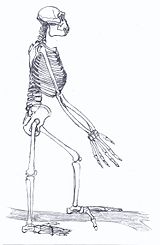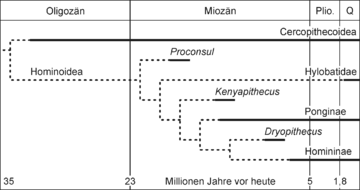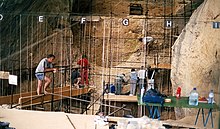Human evolution
![]()
This article describes the descent of man. For the formation of the characteristic features of man, see hominization.
Human phylogeny is the evolutionary emergence of modern humans (Homo sapiens) and their closest relatives from common ancestors. According to the current view, the phylogeny of humans began with the split of the last common ancestral population of chimpanzees and humans. The one of the two subpopulations from which humans emerged, as well as all their extinct and still living descendants, are called Hominini.
The study of phylogeny "draws into consideration all fossil and present-day life forms of apes within the framework of the doctrine of primates, primate science or primatology, founded by T. H. Huxley as early as 1863."
A steadily growing number of well-preserved fossils from different regions of Africa, Asia and Europe has increased knowledge about the ancestors of man, but has not led to any agreement about their lifespan and distribution areas. This is also due to the fact that the systematic classification of numerous individual finds and the relationships of many prehistoric species are disputed, because research is currently still "at the limits or even beyond the analytical capacity of the data material and the available methods".
Often the species of the Hominini are referred to as follows: the Australopithecines as prehumans; Homo habilis and Homo rudolfensis as prehumans; all later species of the genus Homo (except Homo sapiens) as early humans; Homo sapiens as now-humans or anatomically modern humans. The Hominini are occasionally preceded by the animal-human transitional field named by Gerhard Heberer in 1958.

Cladogram of the family of the great apes (Hominidae) and their subfamilies Ponginae and Homininae as well as of the genera Pongo (orangutans), Gorilla, Pan (chimpanzees) and Homo still living today.
Evolution of the humanoid
"The cradle of the Hominoidea" - the superfamily of humanoid species - "lies in the early Miocene of East Africa," that is, between 23 and 16 million years ago. Their early Miocene forms are called archaic or stem Hominoidea; their relationships to each other and to later species are controversial because of the paucity of known fossils. Furthermore, none of the Miocene anthropoid species known to date exhibit the locomotor physical features typical of apes, "which appear to have evolved only as Pliocene hominoids became increasingly terrestrial," that is, about 5 million years ago.
About 18 to 15 million years ago, two evolutionary lines separated: One led to the gibbons (Hylobatidae), the other to some genera already extinct again in the Miocene - such as Afropithecus, Kenyapithecus and Griphopithecus, Pierolapithecus, Dryopithecus and Oreopithecus - as well as to the great apes, i.e. the orangutans (Ponginae) and the African great apes (Homininae: gorillas, chimpanzees, humans).
Some specialist authors now assume that the great apes could have evolved from the superfamily of the Proconsulidae (Proconsuloidea) that existed in this epoch, for which Proconsul was the eponym and which, according to the palaeontological findings, "was an exceptionally richly shaped taxon that occurred exclusively in tropical forests in Africa and the Arabian Peninsula". Other expert authors consider a sister group to the Proconsul-like more likely, or refrain from speculation altogether: "However, based on current knowledge, none of the known Miocene Hominoidea taxa can be placed in the direct common ancestry of African apes and the phylum Hominini."
initial settlement of Eurasia
Between 17 and 14 million years ago, the climate in Africa became drier, and at the same time there were greater temperature fluctuations during the course of the year. According to current research, these changes in the ecological conditions reduced the diversity of proconsul species; at the same time, early relatives of the guenonids and the anthropoid species (for example Kenyapithecus wickeri, Equatorius africanus and Nacholapithecus) developed into the predominant genera. The fossils from this period show that adaptations to a harder diet were developed, e.g. strong jaws and thick layers of enamel on the molars, and that 16 to 15 million years ago, areas outside Africa - large parts of Eurasia - were also colonised by these species for the first time.
Around 16 million years ago, around the boundary from the early to the middle Miocene, the kin group of the orangutans in Asia separated from that of the other ape species; the extinct genera Ramapithecus, Sivapithecus / Ankarapithecus, Lufengpithecus and Khoratpithecus as well as Gigantopithecus also belong to the kin group of the orangutans. Ramapithecus, whose first fossils were found in northern India in the early 1930s, was erroneously considered the ancestor of the Hominini and thus of humans in the 1960s and 1970s.
Between 13 and 9 million years ago, the number of humanoid species in Europe increased; among others, at least four Dryopithecus species are known from this epoch, in addition to the two finds of Pierolapithecus and Anoiapithecus discovered in Spain. A comparable development took place in Asia in that group of forms whose only survivors are the orangutans.
9.6 million years ago, the so-called Vallesium crisis led to major changes in the ecosystems of Europe: starting from the Spanish Mediterranean region, subtropical evergreen forests disappeared in western and central Europe as a result of gradual cooling; they were replaced by deciduous trees and, in some southern regions, steppes. This climatic change also resulted in a profound change in the animal world - most of the European species of man-like creatures of this epoch became extinct; only Oreopithecus survived until about 7 or even 6 million years ago on an island in the region of Sardinia/Corsica. Furthermore, 5.7-million-year-old fossil footprints on Crete have been interpreted as evidence for a species of ape native to that island, which cannot be Oreopithecus because of its forward-pointing toe position with a big toe and ball (site coordinates: 35° 30′ 55.1″ N, 23° 37′ 29.2″ E35.515305555623.6247777778). The approximately 50 footprints are attributed to a hominin. Possibly the oldest representative of the Hominini known to date, an analysis of tooth roots published in 2017 identified the fossil genus Graecopithecus, whose remains (a mandible and a tooth) were found near Athens and in Bulgaria and dated to 7.2 million years ago.
Between 8 and 7 million years ago, the uplift of the Tibetan Plateau also caused an increase in the duration and strength of the monsoon in Asia. The consequence was - also in Europe - a reduction in the frequency and duration of precipitation, detectable among other things by a spread of C4 grasses. These climatic changes gradually led to the complete extinction of the human species in Europe and to a decline in biodiversity in Asia, from which only the orangutans and the gibbons were ultimately spared.
Development in Africa
The north and east of Africa were also affected by the Vallesium crisis 9.6 million years ago. However, only a few finds dating from 13 to 7 million years ago are known from these regions so far. This had at times led to the assumption that the apes had evolved in Asia and migrated back to Africa. In fact, however, the poorer conditions for fossil emergence - the wetter climate - was one of the main reasons for the paucity of African finds. However, with Nakalipithecus nakayamai from Kenya, which was first described in 2007 and is just under 10 million years old, the somewhat older Samburupithecus, which has been known from Kenya for some time, and Chororapithecus, which was recovered in Ethiopia and is also somewhat older, it can now be proven that Africa was also populated by a large number of human-like species in the middle and late Miocene. In the late Miocene - 8 to 6 million years ago - the evolutionary lines of the gorillas and chimpanzees in Africa also separated from those of the Hominini, whereby it is assumed that the last common ancestor of chimpanzees and Hominini had approximately the body dimensions of the chimpanzees living today.
A genetic analysis published in the summer of 2006 in the journal Nature by the Broad Institute, a joint institute of the Massachusetts Institute of Technology and Harvard University, was interpreted to the effect that the developmental course of the earliest hominins was more unusual than is usually assumed. In this study, 20 million base pairs of human DNA and chimpanzee and gorilla DNA had been compared using the molecular clock. According to the study, an early ape species separated from the ancestors of the Hominini about 10 million years ago. However, these two populations reunited several millennia later and formed a mixed population in which interbreeding occurred.
According to the researchers' interpretations, there was a succession of interbreeding and diverging groups over four million years until a final, permanent separation of the chimpanzee ancestors and the Hominini occurred about 6.3 to 5.4 million years ago. This final gene exchange was said to be evidenced by the consistently very young age of the X chromosomes, which only emerged at this late date in the form characteristic of humans and closely resembled the X chromosomes of the chimpanzee. However, this scenario did not go unchallenged.

The fossil "Ardi", of an Ardipithecus ramidus: drawing after the reconstruction drawing in Science.

The lower jaw of Dryopithecus fontani

Reconstruction of the physique of Proconsul

The differentiation of the humanoid species: Around the boundary from the Eocene to the Oligocene, the evolutionary line leading to the Cercopithecoidea (which includes the guenonids) separates from that of the Hominoidea in the taxon of Old World apes (Catarrhini). The taxon of the Hominoids includes the gibbons (Hylobatidae), the orangutans (Ponginae) and the African great apes (Homininae: gorillas, chimpanzees, humans).
Research History
Early views until the beginning of the 19th century
With reference to Pliny, Andreas Vesalius (1514-1564), the founder of modern anatomy and morphological thinking, had already developed a theory of human descent from apes via pygmies in the 16th century, and the English anatomist Edward Tyson had described the similarities between chimpanzee and human brains in 1699. Apparently, scholarly circles in the 17th century were already aware of the great similarity between humans and apes. However, finds of human fossils in the 18th and early 19th centuries either proved to be errors, such as a giant Tertiary salamander described as Homo diluvii testis, or their "diluvial" context of findings was not recognized. Proponents of diluvial man, which was controversial at the time, included the Thuringian geologist Ernst Friedrich von Schlotheim, who cited fossil human remains ("anthropoliths") from Bad Cannstatt, Bilzingsleben, Meissen, and Köstritz in his "Petrefactenkunde" published in 1820-1822. The first well-preserved and confirmed find of a Pleistocene human to the present day was a skeleton discovered in 1823 on the Gower Peninsula (Wales), dated by C14 dating to 31,000 BP (corresponding to about 35,000 calibrated calendar years before present), called the "Red Lady of Paviland". This is a male burial strewn with red ochre (the sex was initially incorrectly determined) of an anatomically modern human, known as Cro-Magnon Man.
Dissent over origins in the 19th century
It was not until the discovery of the Neanderthal from the Neander Valley in 1856 - three years before the publication of Darwin's magnum opus on The Origin of Species - that circumstantial evidence came to light that there might have been another type of human besides Homo sapiens. Quarrymen had uncovered 16 bone fragments in a section of the Neander Valley that has now fallen victim to lime mining. In 1864, the Irish geologist William King attributed them to a species distinguishable from modern humans, "Homo Neanderthalensis King." Nevertheless, it remained controversial until the end of the 19th century whether the find from Neandertal was a "prehistoric man" or a deformed modern human.
Independently of this research dispute, Charles Darwin had argued in his 1871 work The Descent of Man and Sexual Selection that man probably evolved in Africa because his closest relatives - chimpanzees and gorillas - were native to that continent. The detailed anatomical studies presented by Thomas Henry Huxley in his 1863 paper Evidence as to Man's Place in Nature also suggested that humans evolved in Africa.
Ernst Haeckel, on the other hand, took a completely different approach. As early as 1868, he had written in his Natural History of Creation that "most of the signs pointed to southern Asia". Haeckel based his conjecture primarily on a comparison of the hair, skin colour and skull shape of the peoples of Africa and Asia, who were considered primitive at the time and are now referred to as indigenous, with the great apes. Haeckel, however, conceded at the same time: "Perhaps, however, eastern Africa was also the place where the emergence of primitive man from the human-like apes first took place; perhaps also a continent now submerged under the mirror of the Indian Ocean, which in the south of what is now Asia extended on the one hand eastward as far as the Sunda Islands, and on the other hand westward as far as Madagascar and Africa."
Haeckel's hypothesis that the Sunda Islands were the remnants of the sunken continent of Lemuria, where prehistoric apes evolved into the ancestors of man and the other present-day apes, fascinated the young Dutch military doctor Eugène Dubois. He therefore had himself transferred to Sumatra in 1887 to search for fossils in the area of the Malay Archipelago. In his book The Early History of Man, Friedemann Schrenk describes Dubois' approach as follows: "Obsessed with his idea, he began digging in a place in Java that would be considered utterly hopeless by today's standards. He dug in an area where, within a radius of thousands of miles, even the slightest hint of the remains of a prehistoric man had never before been found-and he dug to within an inch of the right spot." Dubois, however, knew of evidence from farmers who had found animal fossils there.
Haeckel's anatomical comparisons, Dubois' fossil of Java Man from 1891 and the discovery of Peking Man in the 1920s meant that Darwin's reference to Africa as the cradle of humankind was not heeded any further - instead, Asia was regarded by leading researchers as the region in which modern humans had evolved. Initially, the discovery of a well-preserved fossil skull, some two million years old, in 1924 in the village of Taung, now part of South Africa, did nothing to change this. Raymond Dart, an anatomist at the University of the Witwatersrand in Johannesburg, recognized the significance of the find and published it in the journal Nature at the beginning of 1925 under the new species and genus name Australopithecus africanus.
First paleoarchaeological evidence for the origin of humans from Africa
Thanks to his medical, neuroanatomical training, Raymond Dart had recognized that the so-called Child of Taung did possess an ape-like face; however, its brain and dentition were human-like. Dart therefore argued that important features of the small skull were more human-like than ape-like: "The cheekbones, zygomatic arches, maxilla and mandible reveal delicate human-like characteristics." The same was true of the brain, which likewise showed more human-like than ape-like characteristics: Taung's child, he said, should therefore be classified as a mosaic form, that is, as a member of "an extinct race of apes that represents an intermediate link between the apes of the present and humans." However, Dart's interpretation of the fossil was not taken seriously until the 1940s.
A major reason for this was the rejection by the leading US paleontologist of the time, Henry Fairfield Osborn, who, as a critic of Darwin's theory of evolution, had popularized the theoretical concept of a so-called Dawn Man. Among other things, Osborn claimed that the brain of modern man was so complex that two or three million years could not have been sufficient to produce it from an ape-like brain. The small brain of Australopithecus africanus with human-like teeth was thus a find that was not consistent with the hypotheses of the scientific establishment of the time: almost all researchers therefore endorsed Osborn's thesis in the 1920s. They assumed a time span of at least 20 to 25 million years since the separation of the Hominini from the other apes: A hypothesis, which was by no means new, because already Rudolf Virchow had not recognized the Neanderthal as a fossil species out of similar considerations. In the 1920s, however, this hypothesis, which today seems completely arbitrary, found plausible support in Piltdown Man, whose bones had been collected in Sussex from 1912 onwards and which was only exposed as a fake in 1953. His head consisted of the skull of a modern human to which the lower jaw of an ape had been adapted. The forgery accommodated the prevailing view of the time, according to which the ancestors of man had long possessed a particularly large brain, and thus blocked the view of the leading British and US palaeontologists of the time from the actual facts.
The turning point in favor of recognizing the Australopithecines as prehumans did not occur until the significance of other fossils was reevaluated. Thus, more and more Neanderthals had been discovered whose body structure was uniform and which thus made the thesis untenable that the first specimen found was a deformed modern human. From 1936 onwards, more Australopithecus fossils were discovered in Africa, which were no longer interpreted by a new generation of researchers primarily against the background of the older doctrines on the duration of the evolution of the brain.
Establishment of the Out-of-Africa Theory
Particularly significant fossils were discovered from the late 1950s / early 1960s by the married couple Louis Leakey and Mary Leakey and later by their son Richard Leakey and his wife Meave Leakey in the Olduvai Gorge in present-day Tanzania and at Lake Turkana in Kenya. Since the 1970s, researchers led by Yves Coppens, Donald Johanson and Tim White have recovered numerous fossils in the Afar Triangle in Ethiopia. In 1991, the German researcher Friedemann Schrenk discovered in Malawi the second oldest fossil attributed to the genus Homo after the LD 350-1 fossil, the complete lower jaw UR 501 of Homo rudolfensis. The most complete skeleton of an early representative of the Hominini discovered to date is the Little Foot fossil from Sterkfontein (South Africa), worked on by Ronald J. Clarke, which has been in the process of being uncovered since 1997.
In particular, the decades of research by the Leakeys, the development of a reliable dating method for East African finds by Frank Brown, and the comparative anatomical studies by Günter Bräuer were instrumental in establishing and consolidating the Out-of-Africa theory of the origin of modern humans over the multi-region theory. The Out-of-Africa theory has been the accepted theory of the regional origin of humans since the 1980s; indeed, to date, only hominin fossils younger than two million years are known outside of Africa. Recently, there has also been talk of a modified Out-of-Africa theory, which takes into account the fact that the evolution of modern humans also took place to a small extent outside Africa by way of interspecific gene flow.
.jpg)
The family tree of man according to Ernst Haeckel
_1-EditMylius.jpg)
The child of Taung

Excavation work in the cave of Arago
Questions and Answers
Q: What is human evolution?
A: Human evolution is the origin of human beings. It is the process by which humans evolved from earlier species, such as Australopithecines, to modern Homo sapiens.
Q: Where did humans first appear?
A: Humans first appeared in Africa, according to fossils found there.
Q: How long ago did Homo sapiens evolve?
A: The first Homo sapiens evolved around 200,000 years ago.
Q: What are primates?
A: Primates are a group of mammals that includes monkeys, apes, lemurs and tarsiers. They are closely related to humans and share many similar anatomical features.
Q: When did human evolution begin?
A: Human evolution began at least 5 million years ago when a group of apes (now called australopithecines) started living more in the savannah and began walking on two legs and using their hands to carry things.
Q: What does "Homo" mean?
A: The biological name for "human" or "man" is Homo. This word comes from Latin meaning “man” or “human being”.
Q: What is Paleoanthropology? A:Paleoanthropology looks at ancient human fossils, tools, and other signs of early human life in order to understand how humans have evolved over time.
Search within the encyclopedia